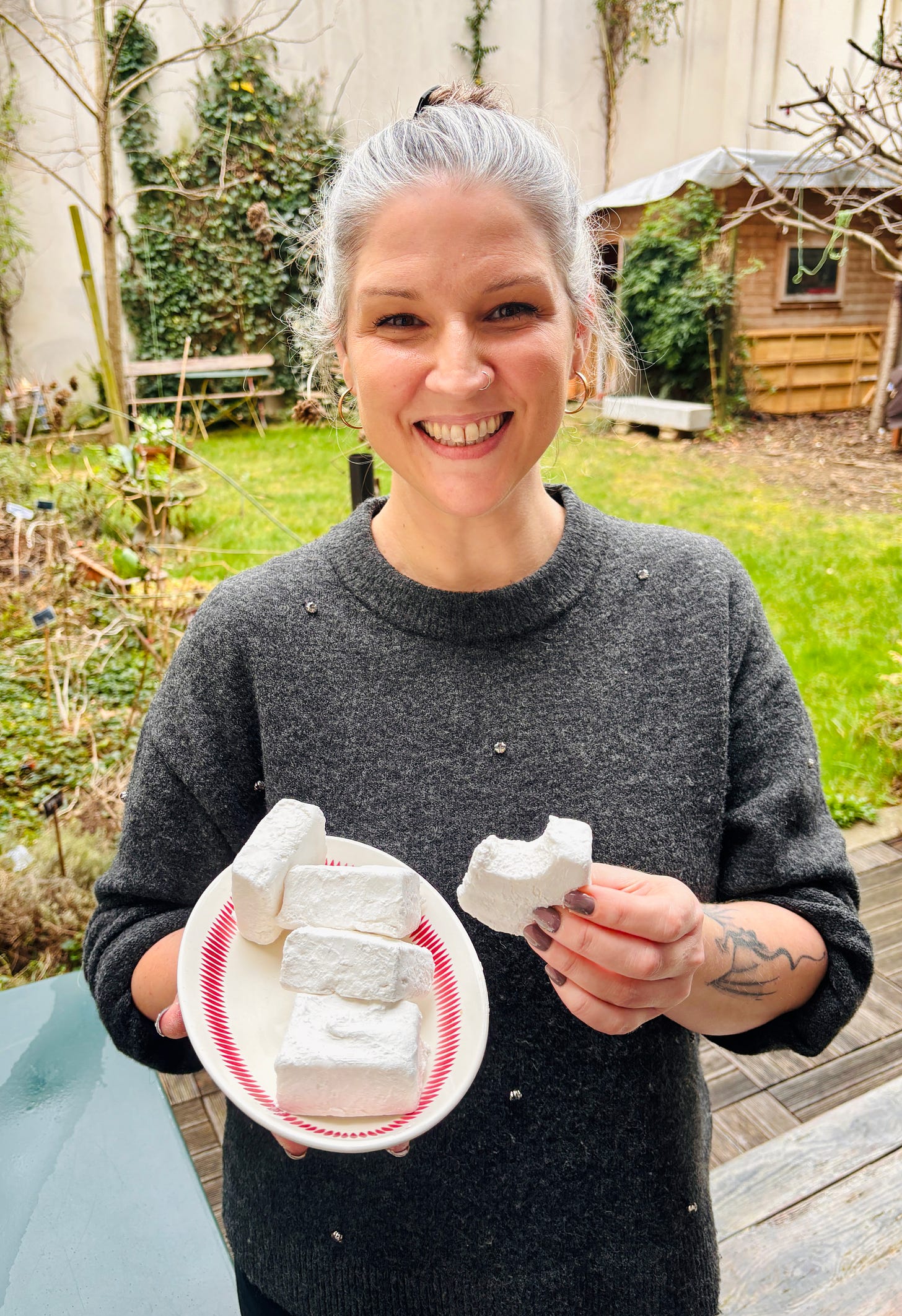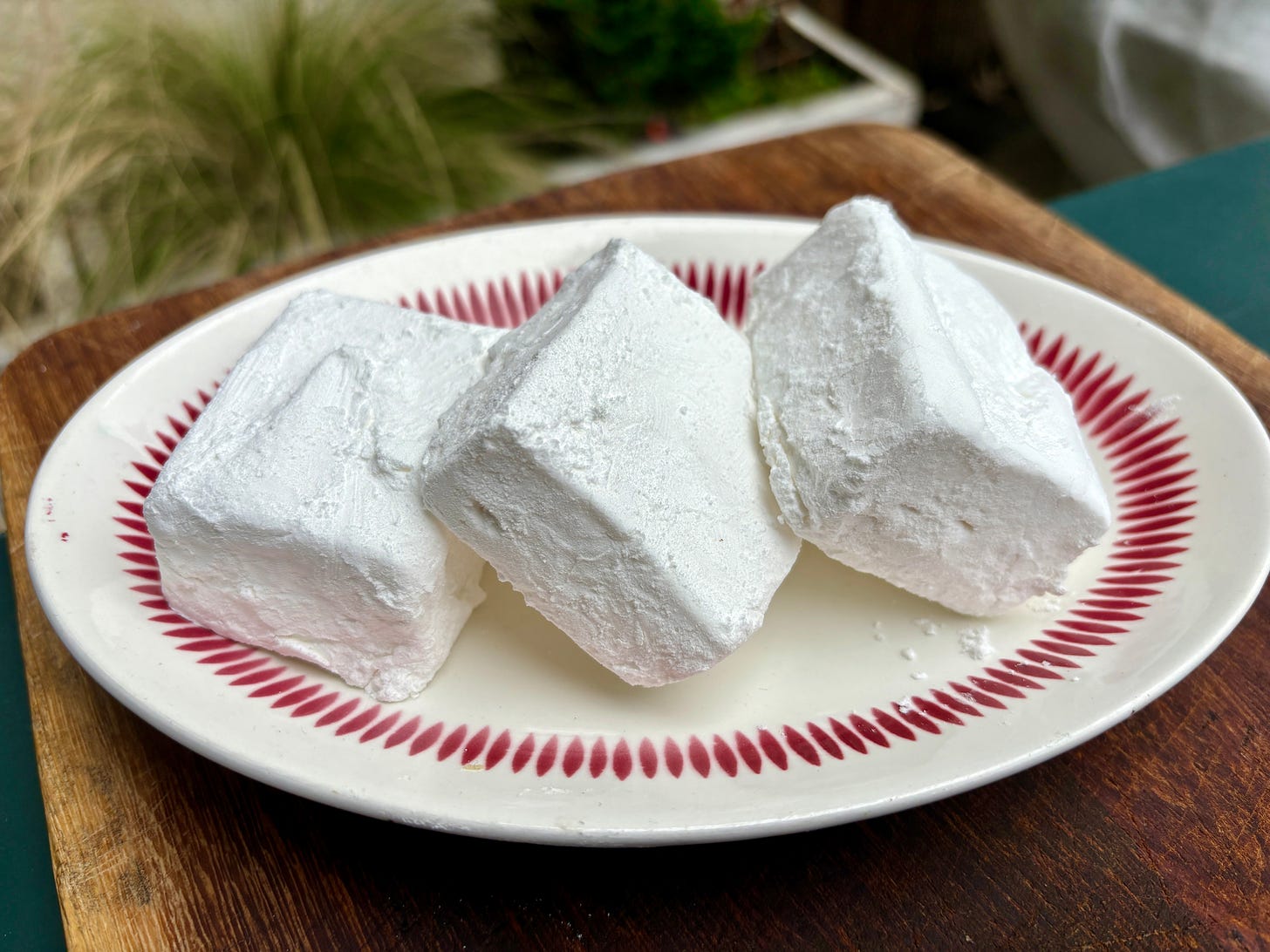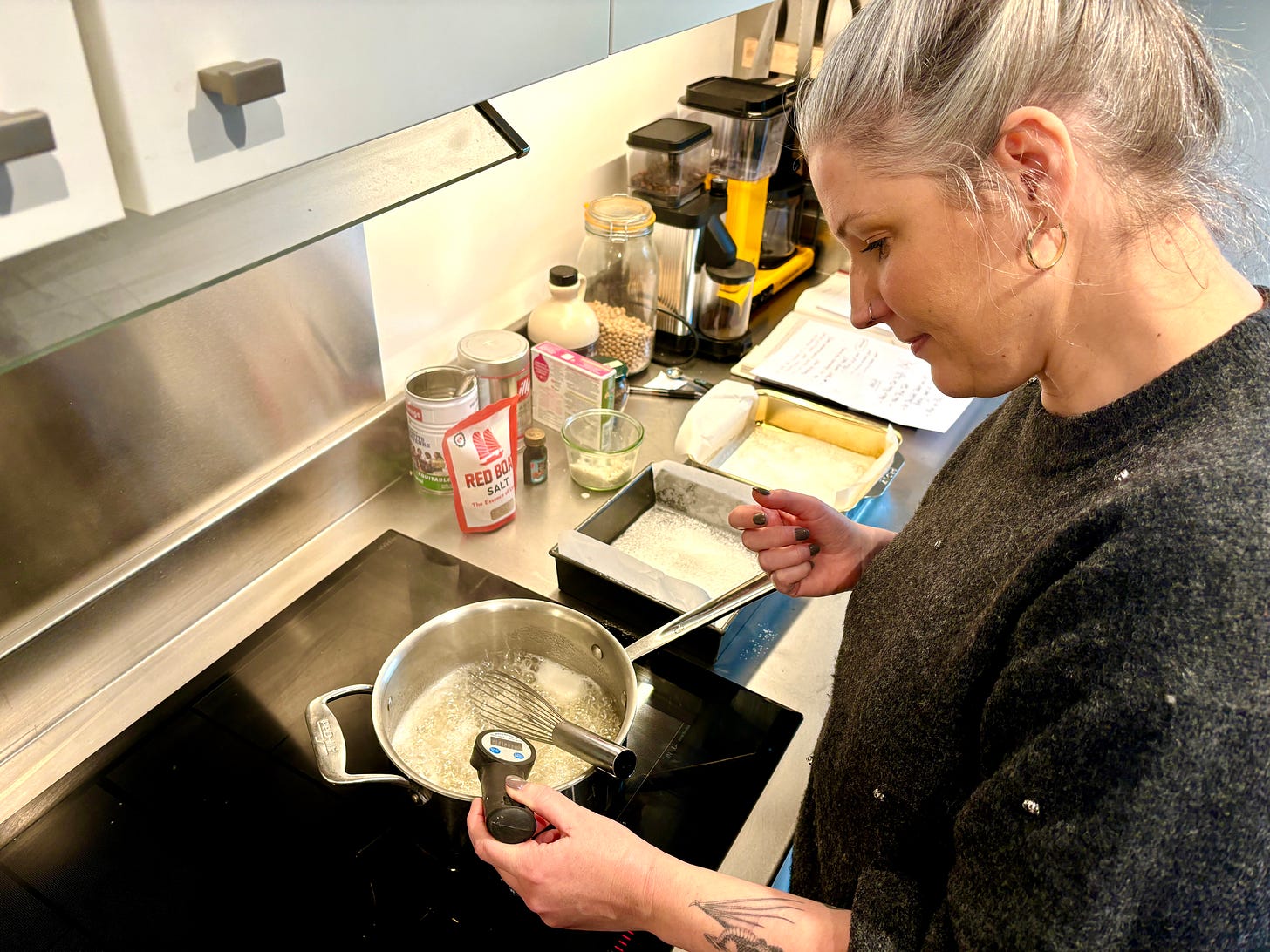One thing that happens when you write a cookbook is that you have a lot of egg whites left over. That was especially true when I wrote The Perfect Scoop and used egg yolks for making a gazillion batches of ice cream, which coincided with the time Romain learned about egg white omelets and frittatas, which went on heavy rotation. (Pro tip: Adding a whole egg or two to the whites “hides” the fact that it’s mostly egg whites.)
I often use up a lot of egg whites for my coconut macarons, which take a full cup of egg whites. That’s a good recipe as it’s easy to put together, and you can stick the batter in the freezer and deal with it later. (Although finding freezer space can be a job in itself!) As nice and helpful as people are, suggesting that you make a Pavlova or angel food cake is just adding to your project list, which doesn’t move the needle forward in testing new recipes.
Here’s a look at the 4-6 hours I spent one day using up a batch of test marshmallows that wasn’t quite up to snuff:
Marshmallows are a popular recipe to make* with them because, like angel food cake and Pavlova, they use a lot of egg whites. But I’ve got other fish to fry at the moment, or, rather, tarts to bake, cookies to cut, cakes to conjure up, and sugar to brûlée.
France has often been considered “vegetarian hell” and even worse for vegans. Thankfully, a lot more restaurants are paying attention to changes in the way people eat; many restaurants offer at least a few dishes that are vegetable-centric. It’s hard to make a list because places change their menu daily, but it’s nice to see more choices like that on menus. Calling first or leaving any allergies or dietary restrictions in the comments on the online reservation form is also a good idea, so they know in advance.
Paris has also changed in other ways, and American food has become more popular. Most of the cupcake shops eventually fell out of favor, along with the Stan Smith sneakers everybody was wearing, including entire families…
…which got traded for Veja vegan sneakers, although those are getting edged out by New Balance baskets. (It’s so hard to keep up!)
Most bakeries still offer les brownies or les cookies (chocolate chip cookies), and shops and local chains, such as Scoop Me a Cookie, continue to have lines of Parisians out the door and down the sidewalk, waiting for cookies that come in several sizes, including géant and XXL.
There was quite a buzz in the media over the opening of Krispy Kreme; as one astute friend here said, “They must have a helluva publicist,” because even the NYT found their open worthy of covering. But the OG has been Boneshaker, owned by pastry chef Amanda Bankert.
Doughnuts are not something I normally crave, although I know and respect people to whom they are a religion, but when I saw that Boneshaker was making a Fluffernutter doughnut, with peanut butter and marshmallow cream, I ran over.
On weekends, Boneshaker has a line out the door. And nope, it’s not Americans. It’s Parisians lining up for vegan doughnuts. That’s right, Boneshaker is all vegan. Amanda took her shop vegan a few years ago, and no one batted an eye.
I had never personally met Amanda, but when her book, Violà Vegan, was ready to be published, she asked for a quote. And when I got a look at the book (via PDF), I was delighted at how she veganized favorite French pastries, including cherry clafoutis, puff pastry, crème brûlée, crêpes Suzette, riz au lait, and even profiteroles, all with a Boneshaker, plant-based twist.
I was most intrigued by the Vegan Marshmallows. People asked me, over and over (and over and over), over the years, about substituting agar-agar for gelatin in my marshmallow recipes. I didn’t have a lot of experience with it. In fact, I didn’t have any. So I couldn’t offer any advice.
So I was interested in giving it a go. Another ingredient I was also interested in trying was aquafaba, the liquid from cooked chickpeas, which can be whipped up to make a meringue that resembles a meringue made with egg whites and, in some ways, is even better.
My first try with it was a flop, which was my fault. (And for the record, C’est ma faute isn’t something you often hear in France.) For one thing, I didn’t know that using the liquid from cooking dried chickpeas at home wasn’t quite the same as using the stuff in the cans or jars of chickpeas, which is more concentrated. And another reason was that I didn’t use the cream of tartar that the recipe called for because I know cream of tartar isn’t easily available, or used, outside of the U.S. And since a number of you live outside of the U.S., I like to make recipes here as accessible as possible. So I took one for the team, or two.
One thing fun about baking is that there’s so much to learn. And another is that bakers (including Amanda) are fun people. So going for the win/win, I invited Amanda over to make another batch with me.

Amanda arrived with a box of delicious treats for me (yay for fun bakers!) and the ingredients to make vegan marshmallows, which I had also purchased.
We decided to make two batches, one with the liquid from canned chickpeas (hers) and one with my homegrown chickpea liquid, which I hadn’t realized before was the culprit. I also was curious about using cream of tartar in them, which a vegan website in France called an “ingrédient magique en cuisine végane.” So I wanted to see if it truly was magique, and obligatoire.

Both of our egg whites…oops, I mean, our aquafaba meringues whipped up fine, although Amanda’s was more sumptuous. But when we added the sugar syrup to our respective batches, mine deflated into a sticky wad and hers remained lofty and sweetly proud.
Because I’m sort of crazy for Chartreuse, I added a tablespoon of Chartreuse Elixir, a concentrated form of Chartreuse that’s still made from the original recipe, from 1764, which was originally taken as a remedy for what ails you. It’s now available in the U.S. (despite the current scarcity of the traditional liquor), but you can use regular green Chartreuse or another liquor in them. Or, you can make them for the kids and go with vanilla.
In addition to learning about aquafaba, I also learned a new French word during the process—égayer, from the box of food coloring I got from the natural food store, hoping to give my marshmallows a little green tint…naturally.
Égayer means to brighten or liven something up, but the entire package of light green powder (made with stinging nettles) didn’t really do anything…except make me feel a little smug about myself for not succumbing to using traditional food coloring. Like CBD, it held a lot of promise but wasn’t really the same thing.
Since we’re being honest, I think I prefer the vegan marshmallows to the egg white–based ones, although I have so many egg whites, I’m not ready to go completely vegan yet. But Romain has been wolfing these down, and I’m not sure if it’s the Chartreuse or the marshmallows. But after making five batches of marshmallows in the last 10 days, I’m happy to have someone around to eat them.
A few notes on the recipe:
Use the liquid from canned or jarred chickpeas. I’ve seen instructions online for using the liquid from cooked chickpeas, reducing it to the same syrupy consistency of canned chickpeas, but I haven’t tried that. Be sure to shake the can of chickpeas and aquafaba before using. Apparently, the “good stuff” in it that makes it whip, can sink to the bottom.

Cream of tartar is a stabilizing agent for egg whites. Usually, I make it optional, but here it’s important. (America’s Test Kitchen tested aquafaba with and without it, and their results clearly showed what a good idea it is to use it.) Cream of tartar is common to find in the U.S., in the baking or spice aisle, but outside of the U.S., it may be trickier to track down. G. Detou and In Good We Trust in Paris carry it, and you can find “crème de tartre” online in France and the rest of the world.
I was surprised and delighted to see agar-agar sold in many supermarkets in France, as well as at natural food stores. I did find Xanthan gum in the cosmetics department at Biocoop, but G. Detou also carries it. If you live elsewhere, if you can’t find the ingredients near you, you can also find them online.
Vegan Marshmallows
Adapted from Voilà Vegan by Amanda Bankert
Makes one 8-inch (20cm) square slab of marshmallows, which will yield 12-36 marshmallows, depending on what size you cut them.
For the aquafaba, you want to use the liquid from canned or jarred chickpeas. I used Chartreuse elixir in mine, but you can use regular green Chartreuse, rum, brandy, or another favorite libation, or use vanilla extract. Amanda’s original recipe called for 1 tablespoon, but I found 2 teaspoons of vanilla was fine to use. Taste, and add the additional vanilla if you’d like.
[A quick note: The first version of this post/recipe went out without the agar agar in the ingredients. It’s added here and I updated the printed version, too.)
1/2 cup (60g) powdered sugar
1/2 cup (60g) cornstarch
3/4 cup (175ml) aquafaba
1/2 teaspoon Xanthan or guar gum
1/4 teaspoon cream of tartar
1/2 cup (125ml) water
2 cups (400g) sugar
1/4 cup (60ml) light corn syrup
2 teaspoons agar agar powder (not flakes)
1 tablespoon liquor (see headnote) or 2 to 3 teaspoons vanilla extract
Mix together the powdered sugar and cornstarch in a medium-sized mixing bowl. Spray an 8-inch (20cm) square cake pan with nonstick spray, or drizzle a little neutral-tasting oil in the pan and spread it around with a paper towel. Cut a rectangular piece of parchment paper so it covers the bottom and up and over two sides facing each other in the cake pan, with enough parchment to leave an overhang of paper, which will help remove the marshmallow later. Sift some of the powdered sugar and cornstarch mixture into the cake pan so it’s in an even layer on the bottom. Tilt the pan a bit and sift some of the mixture over the sides.
(If you don’t have an 8-inch pan, you can use a similar-sized cake or baking pan, or just line a small sheet pan with parchment paper and sift an even layer of the sugar and cornstarch mix over it, roughly 8-inches (20cm) round or square.)
In a stand mixer fitted with the whip attachment, start whipping the aquafaba, Xanthan gum, and cream of tartar on high speed until very light and fluffy, until it forms stiff peaks, about 10 minutes. (Don’t worry about overwhipping it. Unlike egg whites, you can’t overwhip aquafaba.)
Pour the water into a medium saucepan (at least 4 quarts/4L) with high sides. Add the sugar and stir until combined, then add the corn syrup and agar agar. (If using a clip-on candy thermometer, clip it to the side of the pot now.) Heat the mixture over high heat and cook, stirring only if the ingredients start clumping together or it threatens to boil over, until it reads 250ºF (120ºC) on an instant-read thermometer or the clip-on thermometer.
With the mixer running on medium-high speed, in a steady stream, gradually pour the hot syrup into the aquafaba, pouring the syrup between the side of the bowl and the whip; if you pour it directly on the whip, or on the side of the bowl itself, the syrup will stick to them and not get into the meringue.
Once you’ve added all the syrup, increase the mixer speed to high and whip for 5 minutes until the meringue is stiff and shiny, and the outside of the mixing bowl no longer feels warm to the touch. Add the liquor or the vanilla and whip the meringue a little more to incorporate it.
Scrape the marshmallow mixture into the prepared pan and use a spatula to even it out. Sift another layer of the powdered sugar mixture over the top and refrigerate, uncovered, for 20 to 30 minutes.
Run a sharp knife dipped in hot water (shaking off any excess) to loosen the two sides of the marshmallow mixture from the sides of the pan. Using the overhanging paper as handles, lift out the marshmallow mixture and set it on a cutting board. With the help of the knife, again dipped in hot water, separate the parchment paper from the sides of the marshmallow, flip the marshmallow square over, and peel away the parchment paper. Use the knife to cut the marshmallows into squares.
Working in batches, toss a few of the marshmallows in the powdered sugar mixture and shake them a few times in a mesh strainer to remove excess powdered sugar. After you’ve coated each batch, set the marshmallows on a wire rack or a baking sheet dusted with some of the powdered sugar mixture and leave overnight, uncovered, to dry.
Storage: The marshmallows will keep in an airtight container up to a week, at room temperature.
*…but who knew the ire that marshmallows that could bring?
I put a link to a marshmallow recipe on my Facebook page, one that I thought had egg whites in it, but didn’t. Oops. I went to bed and woke up to a slew of accusations, including one that said I was guilty of doing “the old bait-and-switch” (which I didn’t know was a scam that applied to candy recipes) and another suggesting that I had committed “fraud.” 🤷🏼 😅



















You are the best! Slipping in a little comment "'C’est ma faute' isn’t something you often hear in France" kept me chuckling..
Yummmalicious David!!! Marshmallows have never been a big attraction for me but home made marshmallows using delicious Chartreuse is going to be sublime and spectacular!! Excited!! Wonderful newsletter!! Thanks so much!! 😀